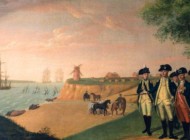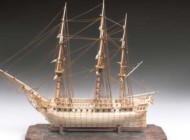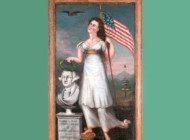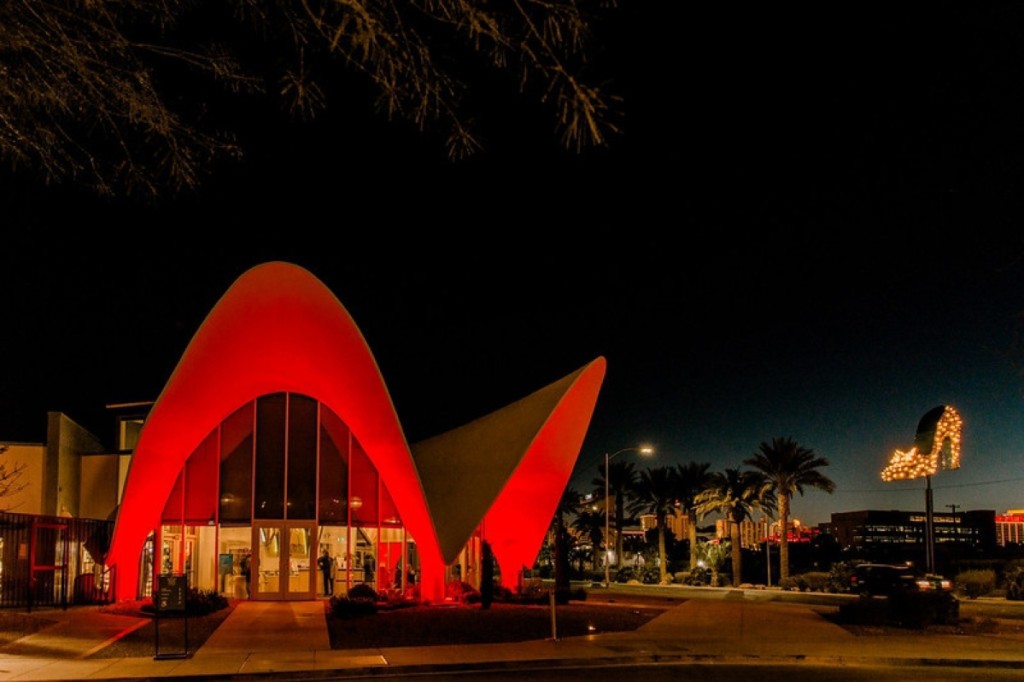
The Neon Museum Visitor Center is housed in the flaring Space Age lobby of the La Concha Motel, originally built in 1961.
By Karla Klein Albertson
LAS VEGAS – When people think of Las Vegas, they recall glitzy casinos in enormous hotels along a dazzling strip in the desert. And no one forgets how the city is illuminated at every turn by fantastic neon signs. There have been excellent artists, such as Bruce Nauman, who have used neon as their medium of choice. But these commercial neon signs spring from industrial designers displaying their own type of artistry and a sly sense of humor. The result has been bright statements that punch home a memorable message. Fly into the city at night – an unforgettable experience.
Local hot spots may come and go but – like the frescoes and stone carvings of earlier eras – the best of these signs deserve a permanent home of their own. And that is the purpose for which the Neon Museum was founded in 1996. The collection began with decommissioned pieces donated by the Young Electric Sign Company (YESCO) and has grown to more than 250 examples through acquisition and donation.
Thanks to the enormous size of some pieces in the permanent collection, the 2.27-acre facility is mostly open to the sky. Touring the rows of salvaged signs, visitors and locals have agreed that the creative use of neon is an art form that should be chronicled and preserved. Signs have been restored or illuminated in innovative ways, and there is an immersive audiovisual spectacle appropriately titled “Brilliant.”
Currently, the museum is offering “Lost Vegas” which runs through February 15. The special exhibition was the brain child of artist and film director Tim Burton, whose dark and quirky productions run like a twisted thread through American cinema. Everyone has a favorite film and maybe another they might be too scared to watch, for his moods range from true horror to the romantic pathos of Edward Scissorhands (1990). A poster for Sleepy Hollow (1999) on this writer’s wall sends its daily warning: “Heads Will Roll.”
The reasons behind Burton’s choice of the Neon Museum for this elaborate project turns out to be a natural affinity between this imaginative director and a most unusual setting. There are over two dozen exhibits, including 20 created especially for this show. Some sail and stalk around the signs in the Boneyard, while smaller, more fragile pieces are in view in a dome by the Visitor’s Center.
 Rob McCoy, president and chief executive officer of the Neon Museum, explained in a video interview: “First of all, Tim Burton called us – he chose us, which makes us feel kind of special. But if you think about it, we’re probably one of the most unconventional museums in the world, and Tim Burton is one of the most unconventional artists and directors in the world – it’s a perfect match. And this was a collaborative effort.” Joanne Russ, the art programs manager, agreed: “Tim Burton has a special relationship with Las Vegas, and he is very supportive of the work that the Neon Museum does.”
Rob McCoy, president and chief executive officer of the Neon Museum, explained in a video interview: “First of all, Tim Burton called us – he chose us, which makes us feel kind of special. But if you think about it, we’re probably one of the most unconventional museums in the world, and Tim Burton is one of the most unconventional artists and directors in the world – it’s a perfect match. And this was a collaborative effort.” Joanne Russ, the art programs manager, agreed: “Tim Burton has a special relationship with Las Vegas, and he is very supportive of the work that the Neon Museum does.”
Burton himself explained his feelings for the town in a special artist’s statement: “Growing up in Los Angeles, my family took part in many a ‘weekend in Vegas.’ While Dad bet on sports and Mom took on the slots with Grandma, I wandered around an amazing and otherworldly place. Everything felt larger than life in Las Vegas. One of my clearest memories as a child was gazing up at the brightly colored seahorses in the Dunes’ pool, towering above me and spewing elegant streams of water from their mouths.
“Vegas was where I witnessed a woman turn into a gorilla before my very eyes. It was where, as a teenager, I would often drive out on my own for a cheap weekend (Vegas used to be cheap!). I was always a loner, and it was a good place to be alone. I once stayed at the Aladdin when the casino and restaurant were closed down, but they still rented out a few rooms. I must have been the only one in the whole place. I remember staring down the empty hallways, the lights were dim. I felt like I was in The Shining. These strange, dreamlike memories I have of Las Vegas have inspired me artistically throughout my career.”
Jenny He was Burton’s exhibition curator, and she wrote the introduction to the companion volume, Lost Vegas: Tim Burton @ The Neon Museum, which will be essential for fans of his work. Here she stated in part: “By imprinting Hollywood blockbusters with his personal aesthetic, Tim Burton (American, b 1958) has created some of the most iconic films of the last three decades. Whether dark and macabre or colorful and whimsical, the characters and worlds in his movies are unified by the empathy and sincerity that Burton imbues into all facets of his work. His indelible visuals combine with emotional resonance to form a signature style that invites subjective connection from his audiences…”
She continued, “The presentation of Burton’s art in Las Vegas is a rare endeavor where the host institution and city also serve as creative inspirations. The museum’s distinctive campus is transformed through the artist’s singular vision for this original exhibition. The dreamlike concept of “Lost Vegas” is depicted both on small drawings and on a massive skeletal tower. It is a confluence of grand spectacle and intimate memory…”
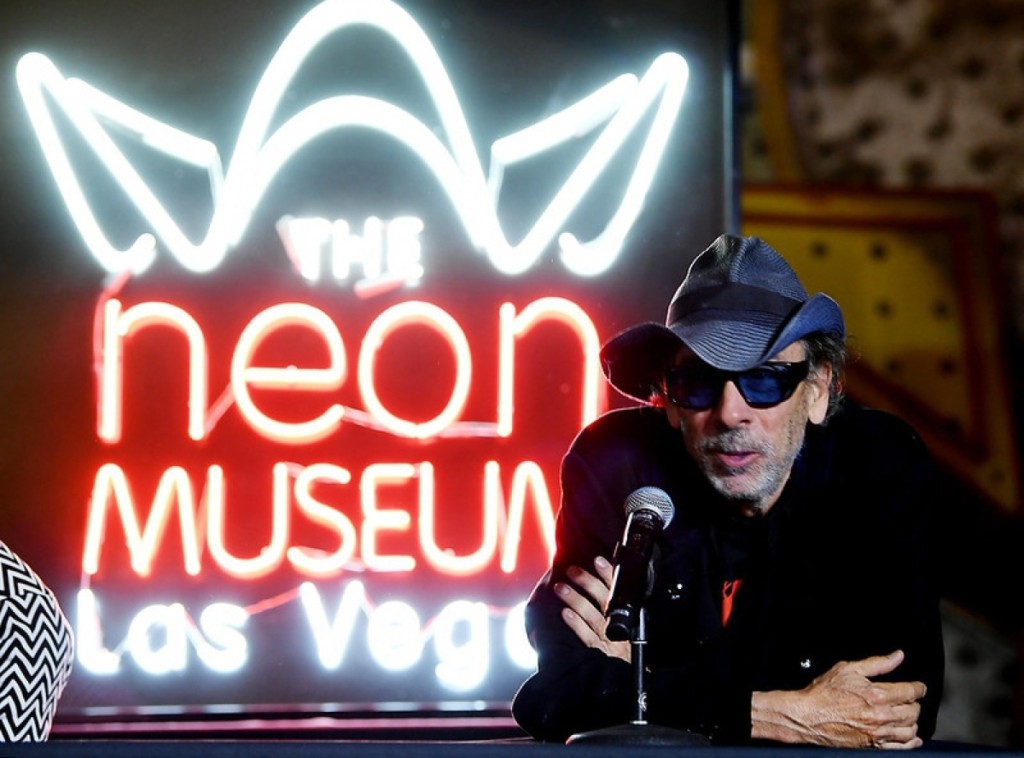
As intriguing as his films, director Tim Burton was onstage for a press conference at the October opening of “Lost Vegas.” Photo by Denise Truscello/WireImage.
“A highlight of the exhibition is the outdoor dome and sign tower that serves as a centerpiece for “Lost Vegas.” A reminiscence of the architecture of bygone structures, it evokes a nostalgia that runs like a current through the entire exhibition. Burton’s beloved Robot Boy, Stain Boy, and other characters first introduced in his 1997 book of illustrated poems, The Melancholy Death of Oyster Boy and Other Stories, star in new art installations that underscore the influence of the city of Las Vegas. Elements of Mars Attacks! and music by The Killers are uniquely purposed in other works that further establish the focused narrative of this exhibition.”
Certainly, those large figures of hideous martians may be the most frightening creatures in the exhibition, especially when viewed in a neon-night setting. They were made for the show from a long list of materials including steel, polyurethane, and Pigmented Glass Reinforced Plastic (GRP). Burton shot scenes for the 1996 film showing the aliens against a backdrop of salvaged signs when they were still onsite at YESCO before their donation to the museum. Viewers can spot the Desert Rose, Golden Nugget and Silver Slipper signs. Another spooky outdoor composition in the exhibition has a variety of Burton-style bugs nibbling on some Boneyard signs.
Although capable of ghastly horror, Burton is also fond of strange sorts of doomed romance scenarios. Jo Russ pointed out a favorite where Robot Boy grasps the hand/lever of his beloved Slot Machine – will they make it? The director himself was on hand for the opening of “Lost Vegas” last fall, talking about the exhibition, greeting fans and signing autographs. Cosplay was the rule at the Boneyard Ball in October where attendees transformed themselves into very credible versions of characters from his films. The band on stage was local favorite The Killers, for whom Burton had produced the music video “Bones” in 2006.
At the end of his artist’s statement, Tim Burton recalls his sadness when landmarks were lost and how he felt when he stood among the salvaged signs: “The emotion of this experience is what ‘Lost Vegas’ is about for me: paying homage to the peculiar, and beautiful past of this city. I want viewers to see Vegas through my eyes: larger than life, colorful, shocking, charming and strange; a place where everyday rules seem not to apply. Unusual, magical and bizarre things were always possible here, and I hope that this show will revive a bit of that for you all.”
The Neon Museum is located at 770 Las Vegas Boulevard North. Maps, history and ticketing information can be found at www.neonmuseum.org. If you want to feel like the bride and groom in Beetlejuice – costumes or an early death required – you can plan a memorable small wedding or schedule a photo shoot.
All images by the Vox Agency, courtesy of the Neon Museum.








.jpg)




